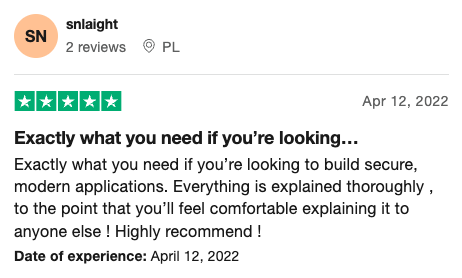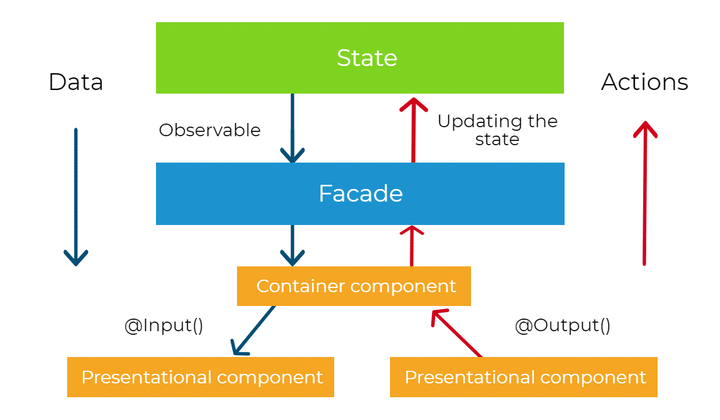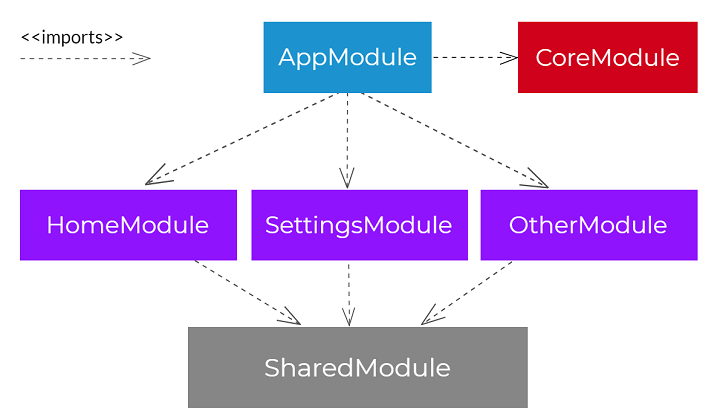Building scalable software is a challenging task. When we think about scalability in front-end applications, we can think of increasing complexity, more and more business rules, a growing amount of data loaded into the application and large teams often distributed around the world. In order to deal with mentioned factors to maintain a high quality of delivery and prevent technical debt, robust and well-grounded architecture is necessary. Angular itself is a quite opinionated framework, forcing developers to do things the proper way, yet there are a lot of places where things can go wrong. In this article, I will present high-level recommendations of well-designed Angular application architecture based on best practices and battle-proven patterns. Our ultimate goal in this article is to learn how to design Angular application in order to maintain sustainable development speed and ease of adding new features in the long run. To achieve these goals, we will apply:
- proper abstractions between application layers,
- unidirectional data flow,
- reactive state management,
- modular design,
- smart and dumb components pattern.

Table of Contents
Problems of scalability in front-end
Let’s think about problems in terms of scalability we can face in the development of modern front-end applications. Today, front-end applications are not “just displaying” data and accepting user inputs. Single Page Applications (SPAs) are providing users with rich interactions and use backend mostly as a data persistence layer. This means, far more responsibility has been moved to the front-end part of software systems. This leads to a growing complexity of front-end logic, we need to deal with. Not only the number of requirements grows over time, but the amount of data we load into the application is increasing. On top of that, we need to maintain application performance, which can easily be hurt. Finally, our development teams are growing (or at least rotating - people come and go) and it is important for new-comers to get up to speed as fast as possible.

One of the solutions to the problems described above is solid system architecture. But, this comes with the cost, the cost of investing in that architecture from day one. It can be very tempting for us developers, to deliver new features very quickly, when the system is still very small. At this stage, everything is easy and understandable, so development goes really fast. But, unless we care about the architecture, after a few developers rotations, tricky features, refactorings, a couple of new modules, the speed of development slows down radically. Below diagram presents how it usually looked like in my development career. This is not any scientifical study, it’s just how I see it.

Software architecture
To discuss architecture best practices and patterns, we need to answer a question, what the software architecture is, in the first place. Martin Fowler defines architecture as “highest-level breakdown of a system into its parts“. On top of that, I would say that software architecture describes how the software is composed of its parts and what are the rules and constraints of the communication between those parts. Usually, the architectural decisions that we make in our system development, are hard to change as the system grows over time. That’s why it is very important to pay attention to those decisions from the very beginning of our project, especially if the software we build is supposed to be running in production for many years. Robert C. Martin once said: the true cost of software is its maintenance. Having well-grounded architecture helps to reduce the costs of the system’s maintenance.
Software architecture is the way the software is composed of its parts and the rules and constraints of the communication between those parts
High-level abstraction layers
The first way, we will be decomposing our system, is through the abstraction layers. Below diagram depicts the general concept of this decomposition. The idea is to place the proper responsibility into the proper layer of the system: core, abstraction or presentation layer. We will be looking at each layer independently and analyzing its responsibility. This division of the system also dictates communication rules. For example, the presentation layer can talk to the core layer only through the abstraction layer. Later, we will learn what are the benefits of this kind of constraint.

Presentation layer
Let’s start analyzing our system break-down from the presentation layer. This is the place where all our Angular components live. The only responsibilities of this layer are to present and to delegate. In other words, it presents the UI and delegates user’s actions to the core layer, through the abstraction layer. It knows what to display and what to do, but it does not know how the user’s interactions should be handled.
Below code snippet contains CategoriesComponent using SettingsFacade instance from abstraction layer to delegate user’s interaction (via addCategory() and updateCategory()) and present some state in its template (via isUpdating$).
1 | ({ |
Abstraction layer
The abstraction layer decouples the presentation layer from the core layer and also has it’s very own defined responsibilities. This layer exposes the streams of state and interface for the components in the presentation layer, playing the role of the facade. This kind of facade sandboxes what components can see and do in the system. We can implement facades by simply using Angular class providers. The classes here may be named with Facade postfix, for example SettingsFacade. Below, you can find an example of such a facade.
1 | () |
Abstraction interface
We already know the main responsibilities for this layer; to expose streams of state and interface for the components. Let’s start with the interface. Public methods loadCashflowCategories(), addCashflowCategory() and updateCashflowCategory() abstract away the details of state management and the external API calls from the components. We are not using API providers (like CashflowCategoryApi) in components directly, as they live in the core layer. Also, how the state changes are not a concern of the components. The presentation layer should not care about how things are done and components should just call the methods from the abstraction layer when necessary (delegate). Looking at the public methods in our abstraction layer should give us a quick insight about high-level use cases in this part of the system.
But we should remember that the abstraction layer is not a place to implement business logic. Here we just want to connect the presentation layer to our business logic, abstracting the way it is connected.
State
When it comes to the state, the abstraction layer makes our components independent of the state management solution. Components are given Observables with data to display on the templates (usually with async pipe) and don’t care how and where this data comes from. To manage our state we can pick any state management library that supports RxJS (like NgRx) or simple use BehaviorSubjects to model our state. In the example above we are using state object that internally uses BehaviorSubjects (state object is a part of our core layer). In the case of NgRx, we would dispatch actions for the store.
Having this kind abstraction gives us a lot of flexibility and allows to change the way we manage state not even touching the presentation layer. It’s even possible to seamlessly migrate to a real-time backend like Firebase, making our application real-time. I personally like to start with BehaviorSubjects to manage the state. If later, at some point in the development of the system, there is a need to use something else, with this kind of architecture, it is very easy to refactor.

Synchronization strategy
Now, let’s take a closer look at the other important aspect of the abstraction layer. Regardless of the state management solution we choose, we can implement UI updates in either optimistic or pessimistic fashion. Imagine we want to create a new record in the collection of some entities. This collection was fetched from the backend and displayed in the DOM. In a pessimistic approach, we first try to update the state on the backend side (for example with HTTP request) and in case of success we update the state in the frontend application. On the other hand, in an optimistic approach, we do it in a different order. First, we assume that the backend update will succeed and update frontend state immediately. Then we send request to update server state. In case of success, we don’t need to do anything, but in case of failure, we need to rollback the change in our frontend application and inform the user about this situation.
Optimistic update changes the UI state first and attempts to update the backend state. This provides a user with a better experience, as he does not see any delays, because of network latency. If backend update fails, then UI change has to be rolled back.
Pessimistic update changes the backend state first and only in case of success updates the UI state. Usually, it is necessary to show some kind of spinner or loading bar during the execution of backend request, because of network latency.
Caching
Sometimes, we may decide that the data we fetch from the backend will not be a part of our application state. This may be useful for read-only data that we don’t want to manipulate at all and just pass (via abstraction layer) to the components. In this case, we can apply data caching in our facade. The easiest way to achieve it is to use shareReplay() RxJS operator that will replay the last value in the stream for each new subscriber. Take a look at the code snippet below with RecordsFacade using RecordsApi to fetch, cache and filter the data for the components.
1 | () |
To sum up, what we can do in the abstraction layer is to:
- expose methods for the components in which we:
- delegate logic execution to the core layer,
- decide about data synchronization strategy (optimistic vs. pessimistic),
- expose streams of state for the components:
- pick one or more streams of UI state (and combine them if necessary),
- cache data from external API.
As we see, the abstraction layer plays an important role in our layered architecture. It has clearly defined responsibilities what helps to better understand and reason about the system. Depending on your particular case, you can create one facade per Angular module or one per each entity. For example, the SettingsModule may have single SettingsFacade, if it’s not too bloated. But sometimes it may be better to create more-granular abstraction facades for each entity individually, like UserFacade for User entity.
Core layer
The last layer is the core layer. Here is where core application logic is implemented. All data manipulation and outside world communication happen here. If for state management, we were using a solution like NgRx, here is a place to put our state definition, actions and reducers. Since in our examples we are modeling state with BehaviorSubjects, we can encapsulate it in a convenient state class. Below, you can find SettingsState example from the core layer.
1 | () |
In the core layer, we also implement HTTP queries in the form of class providers. This kind of class could have Api or Service name postfix. API services have only one responsibility - it is just to communicate with API endpoints and nothing else. We should avoid any caching, logic or data manipulation here. A simple example of API service can be found below.
1 | () |
In this layer, we could also place any validators, mappers or more advanced use-cases that require manipulating many slices of our UI state.
We have covered the topic of the abstraction layers in our frontend application. Every layer has it’s well-defined boundaries and responsibilities. We also defined the strict rules of communication between layers. This all helps to better understand and reason about the system over time as it becomes more and more complex.
Unidirectional data flow and reactive state management
The next principle we want to introduce in our system is about the data flow and propagation of change. Angular itself uses unidirectional data flow on presentation level (via input bindings), but we will impose a similar restriction on the application level. Together with reactive state management (based on streams), it will give us the very important property of the system - data consistency. Below diagram presents the general idea of unidirectional data flow.

Whenever any model value change in our application, Angular change detection system takes care of the propagation of that change. It does it via input property bindings from the top to bottom of the whole component tree. It means that a child component can only depend on its parent and never vice versa. This is why we call it unidirectional data flow. This allows Angular to traverse the components tree only once (as there are no cycles in the tree structure) to achieve a stable state, which means that every value in the bindings is propagated.
As we know from previous chapters, there is the core layer above the presentation layer, where our application logic is implemented. There are the services and providers that operate on our data. What if we apply the same principle of data manipulation on that level? We can place the application data (the state) in one place “above” the components and propagate the values down to the components via Observable streams (Redux and NgRx call this place a store). The state can be propagated to multiple components and displayed in multiple places, but never modified locally. The change may come only “from above” and the components below only “reflect” the current state of the system. This gives us the important system’s property mentioned before - data consistency - and the state object becomes the single source of truth. Practically speaking, we can display the same data in multiple places and not be afraid that the values would differ.

Our state object exposes the methods for the services in our core layer to manipulate the state. Whenever there is a need to change the state, it can happen only by calling a method on the state object (or dispatching an action in case of using NgRx). Then, the change is propagated “down”, via streams, the to presentation layer (or any other service). This way, our state management is reactive. Moreover, with this approach, we also increase the level of predictability in our system, because of strict rules of manipulating and sharing the application state. Below you can find a code snippet modeling the state with BehaviorSubjects.
1 | () |
Let’s recap the steps of handling the user interaction, having in mind all the principles we have already introduced. First, let’s imagine that there is some event in the presentation layer (for example button click). The component delegates the execution to the abstraction layer, calling the method on the facade settingsFacade.addCategory(). Then, the facade calls the methods on the services in the core layer - categoryApi.create() and settingsState.addCategory(). The order of invocation of those two methods depends on synchronization strategy we choose (pessimistic or optimistic). Finally, the application state is propagated down to the presentation layer via the observable streams. This process is well-defined.

Modular design
We have covered the horizontal division in our system and the communication patterns across it. Now we are going to introduce a vertical separation into feature modules. The idea is to slice the application into feature modules representing different business functionalities. This is yet another step to deconstruct the system into smaller pieces for better maintainability. Each of the features modules share the same horizontal separation of the core, abstraction, and presentation layer. It is important to note, that these modules could be lazily loaded (and preloaded) into the browser increasing the initial load time of the application. Below you can find a diagram illustrating features modules separation.

Our application has also two additional modules for more technical reasons. We have a CoreModule that defines our singleton services, single-instance components, configuration, and export any third-party modules needed in AppModule. This module is imported only once in AppModule. The second module is SharedModule that contains common components/pipes/directives and also export commonly used Angular modules (like CommonModule). SharedModule can be imported by any feature module. The diagram below presents the imports structure.

Module directory structure
Below diagram presents how we can place all the pieces of our SettingsModule inside the directories. We can put the files inside of the folders with a name representing their function.

Smart and dumb components
The final architectural pattern we introduce in this article is about components themselves. We want to divide components into two categories, depending on their responsibilities. First, are the smart components (aka containers). These components usually:
- have facade/s and other services injected,
- communicate with the core layer,
- pass data to the dumb components,
- react to the events from dumb components,
- are top-level routable components (but not always!).
Previously presented CategoriesComponent is smart. It has SettingsFacade injected and uses it to communicate with the core layer of our application.
In the second category, there are dumb components (aka presentational). Their only responsibilities are to present UI element and to delegate user interaction “up” to the smart components via events. Think of a native HTML element like <button>Click me</button>. That element does not have any particular logic implemented. We can think of the text ‘Click me’ as an input for this component. It also has some events that can be subscribed to, like click event. Below you can find a code snippet of a simple presentational component with one input and no output events.
1 | ({ |
Summary
We have covered a couple of ideas on how to design the architecture of an Angular application. These principles, if applied wisely, can help to maintain sustainable development speed over time, and allow new features to be delivered easily. Please don’t treat them as some strict rules, but rather recommendations that could be employed when they make sense.
We have taken a close look at the abstractions layers, unidirectional data flow and reactive state management, modular design, and smart/dumb components pattern. I hope that these concepts will be helpful in your projects and, as always, if you have any questions, I am more than happy to chat with you.
At this point, I would like to give a huge kudos to Brecht Billiet who wrote this blog post, that introduced me to the idea of Abstraction Layer and Facade. Thanks, Brecht! Big thank you also goes to Tomek Sułkowski that reviewed my perspective on a layered architecture.





Comments